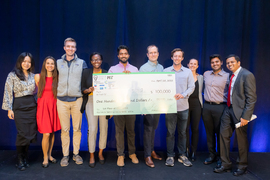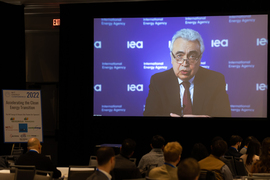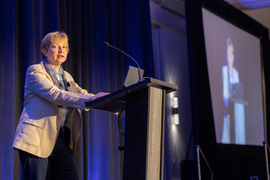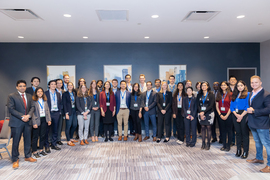This year’s MIT Energy Conference, the largest student-led event of its kind, included keynote talks and panels that tackled some of the thorniest remaining challenges in the global effort to cut back on climate-altering emissions. These include the production of construction materials such as steel and cement, and the role of transportation including aviation and shipping. While the challenges are formidable, approaches incorporating methods such as fusion, heat pumps, energy efficiency, and the use of hydrogen hold promise, participants said.
The two-day conference, held on March 31 and April 1 for more than 900 participants, included keynote lectures, 14 panel discussions, a fireside chat, networking events, and more. The event this year included the final round of the annual MIT Climate and Energy Prize, whose winning team receives $100,000 and other support. The prize, awarded since 2007, has led to the creation of more than 220 companies and $1.1 billion in investments.
This year’s winner is a project that hopes to provide an innovative, efficient waterless washing machine aimed at the vast majority of the world’s people, who still do laundry by hand.
“A truly consequential moment in history”
In his opening keynote address Fatih Birol, executive director of the International Energy Agency, noted that this year’s conference was taking place during the unprovoked invasion of Ukraine by Russia, a leading gas and oil exporter. As a result, “global oil markets are going through a major turmoil,” he said.
He said that Russian oil exports are expected to drop by 3 million barrels a day, and that international efforts to release reserves and promote increased production elsewhere will help, but will not suffice. “We have to look to other measures” to make up the shortfall, he said, noting that his agency has produced a 10-point plan of measures to help reduce global demand for oil.
Europe gets 45 percent of its natural gas from Russia, and the agency also has developed a 10-point plan to help alleviate expected shortages there, including measures to improve energy efficiency in homes and industries, promote renewable heating sources, and postpone retirement of some nuclear plants. But he emphasized that “our goals to reach our climate targets should not be yet another victim of Mr. Putin and his allies.” Unfortunately, Birol said, “I see that addressing climate change is sliding down in the policy agenda of many governments.”
But he sees reasons for optimism as well, in terms of the feasibility of achieving the global emissions reduction target, agreed to by countries representing 80 percent of the global economy, of reaching net zero carbon dioxide emissions by 2050. The IEA has developed a roadmap for the entire energy sector to get there, which is now used by many governments as a benchmark, according to Birol.
In addition, the trend is already clear, he said. “More than 90 percent of all power plants installed in the world [last year] were renewable energy,” mainly solar and wind. And 10 percent of cars sold worldwide last year, and 20 percent in Europe, were electric cars. “Please remember that in 2019 it was only 2 percent!” he said. He also predicted that “nuclear is going to make a comeback in many countries,” both in terms of large plants and newer small modular reactors.
Birol said that “I hope that the current crisis gives governments the impetus to address the energy security concerns, to reach our climate goals, and … [to] choose the right direction at this very important turning point.”
The conference’s second day began with keynote talks by Gina McCarthy, national climate advisor at the White House Office of Domestic Climate Policy, and Maria Zuber, MIT’s vice president for research. In her address, Zuber said, “This conference comes at a truly consequential moment in history — a moment that puts into stark relief the enormous risks created by our current fossil-fuel based energy system — risks we cannot continue to accept.”
She added that “time is not on our side.” To meet global commitments for limiting climate impacts, the world needs to reduce emissions by about half by 2030, and get to net zero by 2050. “In other words, we need to transform our entire global energy system in a few decades,” she said. She cited MIT’s “Fast Forward” climate action plan, issued last year, as presenting the two tracks that the world needs to pursue simultaneously: going as far as possible, as fast as possible, with the tools that exist now, while also innovating and investing in new ideas, technologies, practices, and institutions that may be needed to reach the net-zero goal.
On the first track, she said, citing an IEA report, “from here until 2040, we can get most of the emissions reductions we need with technologies that are currently available or on the verge of becoming commercially available.” These include electrifying and boosting efficiency in buildings, industry, and transportation; increasing the portion of electricity coming from emissions-free sources; and investing in new infrastructure such as electric vehicle charging stations.
But more than that is needed, she pointed out. For example, the amount of methane that leaks away into the atmosphere from fossil fuel operations is equivalent to all the natural gas used in Europe’s power sector, Zuber said. Recovering and selling that methane can dramatically reduce global methane emissions, often at little or no cost.
For the longer run, “we need track-two solutions to decarbonize tough industries like aviation, shipping, chemicals, concrete, and steel,” and to remove carbon dioxide from the atmosphere. She described some of the promising technologies that are in the pipeline. Fusion, for example, has moved from being a scientific challenge to an engineering problem whose solution seems well underway, she said.
Another important area is food-related systems, which currently account for a third of all global emissions. For example, fertilizer production uses a very energy-intensive process, but work on plants engineered to fix nitrogen directly could make a significant dent.
These and several other advanced research areas may not all pan out, but some undoubtedly will, and will help curb climate change as well as create new jobs and reduce pollution.
Though the problems we face are complex, they are not insurmountable, Zuber said. “We don’t need a miracle. What we need is to move along the two tracks I’ve outlined with determination, ingenuity, and fierce urgency.”
The promise and challenges of hydrogen
Other conference speakers took on some of the less-discussed but crucial areas that also need to be addressed in order to limit global warming to 1.5 degrees. Heavy transportation, and aviation in particular, have been considered especially challenging. In his keynote address, Glenn Llewellyn, vice president for zero-emission aircraft at Airbus, outlined several approaches his company is working on to develop competitive midrange alternative airliners by 2035 that use either batteries or fuel cells powered by hydrogen. The early-stage designs demonstrate that, contrary to some projections, there is a realistic pathway to weaning that industry from its present reliance on fossil fuel, chiefly kerosene.
Hydrogen has real potential as an aviation fuel, he said, either directly for use in fuel cells for power or burned directly for propulsion, or indirectly as a feedstock for synthetic fuels. Both are being studied by the company, he said, including a hybrid model that uses both hydrogen fuel cells and hydrogen-fueled jet engines. The company projects a range of 2,000 nautical miles for a jet carrying 200 to 300 passengers, he said — all with no direct emissions and no contrails.
But this vision will not be practical, Llewellyn said, unless economies of scale help to significantly lower the cost of hydrogen production. “Hydrogen is at the hub of aviation decarbonization,” he said. But that kind of price reduction seems quite feasible, he said, given that other major industries are also seriously looking at the use of hydrogen for their own decarbonization plans, including the production of steel and cement.
Such uses were the subject of a panel discussion entitled “Deploying the Hydrogen Economy.” Hydrogen production technology exists, but not nearly at the scale that’s needed, which is about 500 million tons a year, pointed out moderator Dharik Mallapragada of the MIT Energy Initiative.
Yet in some applications, the use of hydrogen both reduces emissions and is economically competitive. Preeti Pande of Plug Power said that her company, which produces hydrogen fuel cells, has found a significant market in an unexpected place: fork lifts, used in warehouses and factories worldwide. It turns out that replacing current battery-operated versions with fuel cell versions is a win-win for the companies that use them, saving money while helping to meet decarbonization goals.
Lindsay Ashby of Avangrid Renewables said that the company has installed fuel-cell buses in Barcelona that run entirely on hydrogen generated by solar panels. The company is also building a 100-megawatt solar facility to produce hydrogen for the production of fertilizer, another major industry in need of decarbonization because of its large emissions footprint. And Brett Perlman of the Center for Houston’s Future said of his city that “we’re already a hydrogen hub today, just not green hydrogen” since the gas is currently mostly produced as a byproduct of fossil fuels. But that is changing rapidly, he said, and Houston, along with several other cities, aims to be a center of activity for hydrogen produced from renewable, non-carbon-emitting sources. They aim to be producing 1,000 tons a day by 2028, “and I think we’ll end up exceeding that,” he said.
For industries that can switch to renewably generated electricity, that is typically the best choice, Perlman said. “But for those that can’t, hydrogen is a great option,” and that includes aviation, shipping, and rail. “The big oil companies all have plans in place” to develop clean hydrogen production, he said. “It’s not just a dream, but a reality.”
For shipping, which tends to rely on bunker fuel, a particularly high-emissions fossil fuel, another potential option could be a new generation of small nuclear plants, said Jeff Navin of Terrapower, a company currently developing such units. “Finding replacements for coal, oil, or natural gas for industrial purposes is very hard,” he said, but often what these processes require is consistent high heat, which nuclear can deliver, as long as costs and regulatory issues can be resolved.
MIT professor of nuclear engineering Jacopo Buongiorno pointed out that the primary reasons for delays and cost overruns in nuclear plants have had to do with issues at the construction site, many of which could be alleviated by having smaller, factory-built modular plants, or by building multiple units at a time of a standardized design. If the government would take on the nuclear waste disposal, as some other countries have done, then nuclear power could play an important part in the decarbonization of many industries, he said.
Student-led startups
The two-day conference concluded with the final round of the annual MIT Climate and Energy Prize, consisting of the five finalist teams presenting brief pitches for their startup company ideas, followed by questions from the panel of judges. This year’s finalists included a team called Muket, dedicated to finding ways of reducing methane emissions from cattle and dairy farms. Feed additives or other measures could cut the emissions by 50 percent, the team estimates.
A team called Ivu Biologics described a system for incorporating nitrogen-fixing microbes into the coatings of seeds, thereby reducing the need for added fertilizers, whose production is a major greenhouse gas source. The company is making use of seed-coating technology developed at MIT over the last few years. Another team, called Mesophase, also based on MIT-developed technology, aims to replace the condensers used in power plants and other industrial systems with much more efficient versions, thus increasing the energy output from a given amount of fuel or other heat source.
A team called TerraTrade aims to facilitate the adoption of power purchase agreements by companies, institutions and governments, by acting as a kind of broker to create and administer such agreements, making it easier for even smaller entities to take part in these plans, which help to enable rapid development of renewable fossil-fuel-free energy production.
The grand prize of $100,000 was awarded to a team called Ultropia, which is developing a combined clothes washer and drier that uses ultrasound instead of water for its cleaning. The system does use a small amount of water, but this can be recycled, making these usable even in areas where water availability is limited. The devices could have a great impact on the estimated 6 billion people in the world today who are still limited to washing clothes by hand, the team says, and because the machines would be so efficient, they would require very little energy to run — a significant improvement over the wider adoption of conventional washers and driers.




















